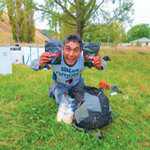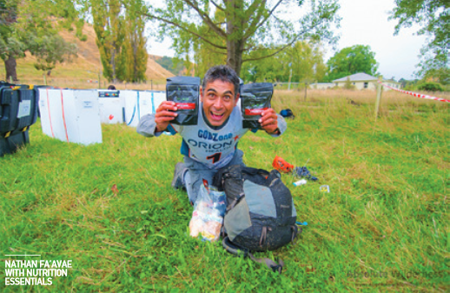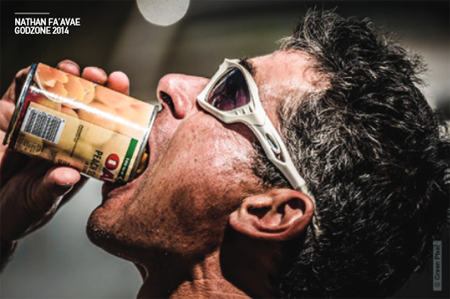
Adventure Racing Nutrition and Bananas
31 August 2015, 8:19AM
Nathan Fa'avae
It is estimated the average adventure racer burns through 7000-12000 calories per day, two to three times that of a normal person in a normal day. Most people in the Western World burn between 1500-3000 calories per day. Endurance athletes need the most calories because they are competing for hours. An adventure racer is often travelling for 20-hours per day. Anyone who has done a multi day expedition length event will know that racing for 4-8-days has many challenges and that fuel is one of them.
Back in the early days of adventure racing it was standard to have support crews, a team of people doing their own style of event, zooming about in vehicles with maps to rendezvous with their teams at transitions areas. A supported race (with support crew) meant that the stages could be shorter and the support crew could prepare food and meals. In the Southern Traverse in 1999 and 2000 we had a chef on our support crew. He asked me pre race what would be a real treat in a transition area. I told him it depends on the time of day but for a morning feed pancakes with fruit, maple syrup and whipped cream, accompanied with fresh coffee would go down really well, and that’s exactly what we had on day three after traversing the Two Thumb Range.
Even without support crews, stages can be short but they tend to be longer, often lasting a day. In the 2014 Godzone Adventure Race in Kaikoura, one team took 53-hours to complete one stage. One important calculation to get right is having enough fuel on board to ensure your body has a constant supply of energy. I’ve often thought how vulnerable the human body is when doing endurance events, we rely so much on a regular intake. Running out of food in a race can have disastrous consequences in terms of racing, a team can be reduced to crawling speed and deplete their bodies to a level that they can’t recover from during the race, no matter how much food they can gain access to. By the time they have refuelled and allowed time for the body to process and assimilate the energy, the race is over. Equally, carrying to much food is an issue also as food is weight. Weight slows you down and also increases calorie demand to produce enough energy to carry it. I see many teams on course who are carrying a lot of food, to produce energy needed to carry a lot of food. I’ve been guilty of that mistake myself. But I got frustrated when I would carry a heavy pack through a tough and difficult stage, only to reach the end and still have a kilogram or more of food in my pack.
It is a hard decision to make deciding how much to carry, you don’t want to run out, but you want to make sure you have enough. Adding to the challenge is guesswork, you often only have a loose prediction of how long a stage is going to be. I’ve done stages that have ended up being twice as long as we anticipated and stages half as long as expected.
Over decades of Adventure Racing we have managed to get the food formula pretty much right.
For the past few years we’ve worked on having something small to eat every hour and something more substantial every six hours.
Most races tend to take us between 80-100 hours so we tend to base our energy needs on going for 90-hours, if we have some left over that’s fine and if we come up short, you can nearly always get more food along the route if needed. In Eco Challenge Fiji in 2002 we ran out of food during a long hiking stage through the jungle. We went through a village and all their little store sold was tinned corned beef and milk powder, so we loaded our packs with that and ate it for the remainder of the stage, while nothing special, it turned out to be good sustenance.
Prior to a race we spend a few hours packing five 12-hour ration bags each, enough for 60-hours of racing. A lot of stages are in the 10-20 hour window and there are normally 6-8 transitions areas. When we are given the course map, we can then quickly remove or add items to our 12-hour bags to suit the stage time.
While it varies depending on our taste buds and what options we have in the country we’re racing in, a 12-hour bag looks like this.
2 x GU Energy Gels
1 x GU Chomps
1 x Energy Bar
1 x Absolute Wilderness Freeze Dry Meal
80-grams cookies
80-grams dried fruit
80-grams salted nuts
80-grams corn chips
80-grams cereal
100-grams salted crackers
100-grams lollies
*We add GU Brew Tablets to our drinking water.
As well as the five 12-hour bags each, we will have enough calories in other food to reach the 90-hour mark. More and more we’re using freeze dried meals to boost our 12-hour bags. There are a lot of reasons for this and we’re using less and less regular food and replacing it with freeze dry technology. We have been using Absolute Wilderness meals, because of their advanced drying technology and not containing any dehydrated ingredients, which can leave you thirsty afterwards. The meals fully hydrate with cold water, a massive bonus for Adventure Racing. I acknowledge that a cold Butter Chicken is not for everyone, but I can testify that in the thick of an adventure race, it’s a pleasurable culinary delight. The Apples and Creamed Rice meal is designed to be eaten hot or cold, and the Raspberries and Yogurt is a cold water hydrate meal, as are the Feijoas.
The biggest advantages are that freeze dry meals are nutritionally more energy dense than anything else you can carry for the same weight, so in a weight energy equation they will win hands down. Because a 500-calorie meal can weigh only 100-grams, if you end up carrying it and not eating it, the penalty is minor. The Scrambled Eggs meal is a great source of high quality protein containing tasty bacon, chives and zesty hollandaise sauce, it’s a whopping 1030-calories for 100grams. Another big advantage is the taste, Absolute Wilderness meals are properly cooked meals with basic natural ingredients, so your body will relish them. Because most meals only require 250mls of water, they are quick and easy to prepare. Add the water, wait 10-minutes and tuck in.
When I’m packing for the race, if there is a stage that is expected to take 20-hours, I’ll simply take a 12-hour bag and 4-5 Freeze Dry meals. This is a safe bet as I know I have enough calories on board and if I do consume them all and still run out, I’ll have enough gas in the tank to get to the end of the stage.
If convenient, we will try and race the first day with fresh food, sandwiches, bakery cakes and fresh fruit.
In our Transition Boxes we’ll load one can of drink and 1-2 cans of food per person (Baked Beans, Fruit Salad, peaches etc). Added to that is personal preference, I like tomato juice at transition areas, some of the meal replacement drinks can be easy ways to load up.
Most people will know that savoury food is what is often craved once you get into the meat of an adventure race. Sweet sugary foods are less appealing and teeth and mouth are sometimes very sensitive after a few days. I’ve seen some teams loading their food and it’s primarily sugar. I don’t think you can have a strong performance and enjoyable race if that’s all you’re eating. It’s important to have a good variety and often in a race you don’t actually feel like eating but know you have to. One thing I can always eat in a race but is quite hard to find is bananas. In Costa Rica in 2013 we were doing a long hiking stage, we were about 65km through the 90km, it was hot and I was hungry, but not inspired by much I had in my pack. Jogging through the jungle on a narrow trail, out of the corner of my eye I caught a glimpse of yellow. I investigated. A few minutes later I caught up to my team who had waited, somewhat impatient as they didn’t know why I had stopped, but when they saw my armfuls of fresh bananas, smiles greeted me. Later on in that race we passed through a Guava plantation so we munched on them for a while, fruit is always a treat.
Racing in France one time, we hiked through a village at night. One house had tomato plants loaded with tomatoes within arms reach of the footpath. They went down well too.
The taste buds often give their approval for savoury food containing fats and oils. Racing in Brazil one year we threw a few tins of Sardines into a TA box. Little did we know at the time they would later be a delicacy on course. If we have room in our TA box and the climate will allow it, having some fresh fruit and vegetables is great replenishment.
In the first Godzone we loaded up a TA box with avocados, tomatoes, creamed cheese and salted crackers. We scoffed them down wandering around Mount Earnslaw, savouring every mouthful and feeling refreshed and energised as a result. By comparison, high in the mountains of Krsyzakstan in 2003, we were getting very low on food, it was dark and really cold. Ahead in the distance we saw a camp fire so we hiked closer to see who was there. It was a small group of herdsmen, huddled around a big pot over a flame. They motioned for us to sit by the fire and swiftly filled some bowls of soup and handed them to us, ripping some bread of a loaf to accompany it. We gobbled it down hungrily, the hot liquid soothing our mouths. Fifteen minutes later when, with full bellies we got up to leave, curiously, I lifted the pot lid and shone my light in, staring up at me was a goats head, still the best soup I’ve ever had.
Keep an eye on the Absolute Wilderness range, there could be a Goats Head with Fennel Seed on Dry Bread Soup coming soon.

Nathan Fa’avae With Nutrition Essentials © Absolute Wilderness

Nathan Fa’avae Godzone 2014 © Green Pixel
Originally published in New Zealand Triathlon & Multisport Issue 100, January 2015
